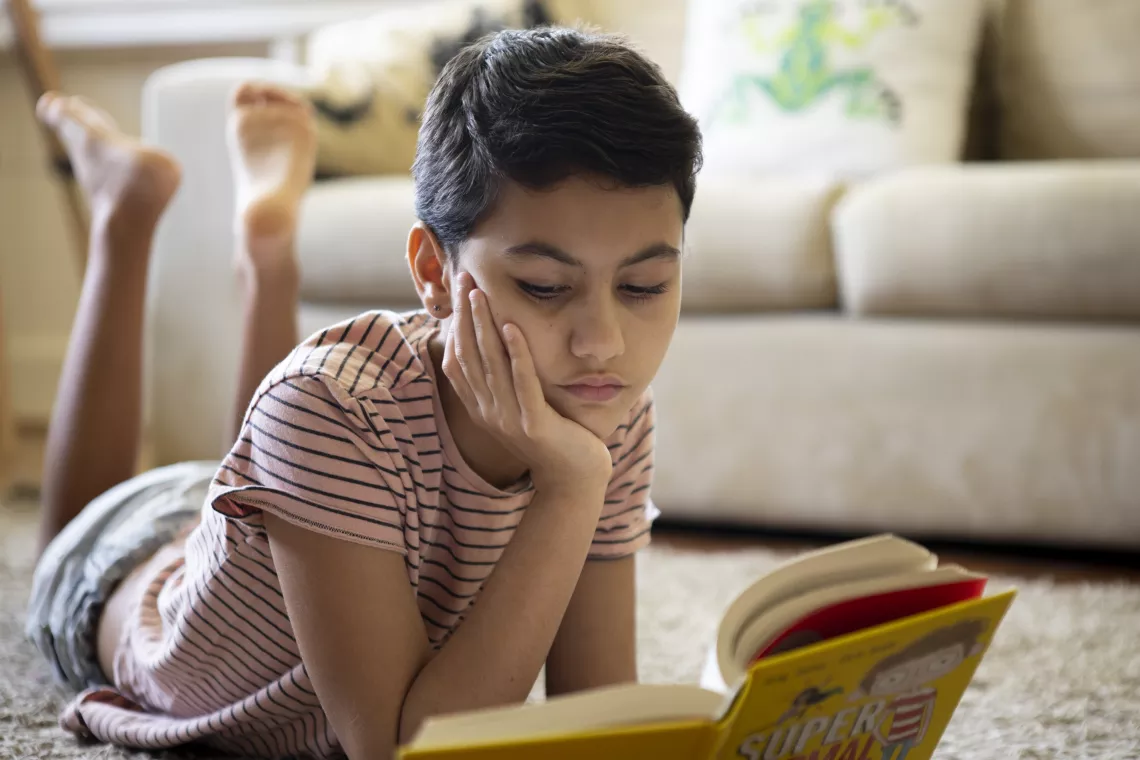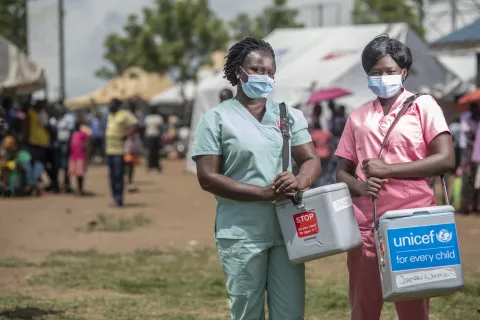Keeping the world’s children learning through COVID-19
With around 1.6 billion children unable to attend school in person, UNICEF is finding ways to keep them learning at home.

The numbers are unprecedented, the implications enormous. As the COVID-19 pandemic has spread across the globe, a majority of countries have announced the temporary closure of schools, impacting more than 91 per cent of students worldwide – around 1.6 billion children and young people.
Never before have so many children been out of school at the same time, disrupting learning and upending lives, especially the most vulnerable and marginalised. Here are some of the ways UNICEF is working with partners to keep schools safe and students learning, in classrooms or at home, online and offline – wherever they are.
Ukraine

When educational facilities across Ukraine closed in March to help contain COVID-19, many families found themselves struggling to keep their children’s education on track.
Since the school closures, UNICEF has been supporting the Ministry of Education and Science with distance learning options for students to ensure continuity and help parents, caregivers and teachers access remote education resources and support during quarantine.
Ukraine is also one of the first countries since the COVID-19 pandemic to roll out its online curriculum through the Learning Passport, a global learning platform launched by UNICEF and Microsoft to help children and youth affected by COVID-19 continue their education at home.
Rwanda

More than 3 million students are out of school in Rwanda since the government recommended schools close to help prevent the spread of COVID-19. To keep children learning, the country has turned to one of its most accessible mediums: radio.
UNICEF identified more than 100 radio scripts from around the world focusing on basic literacy and numeracy that could be adapted to align with Rwanda’s school curriculum. It then worked with partners, including the Rwanda Broadcasting Agency, to produce and air the classes around the country.
Timor-Leste

Timor-Leste is also rolling out its curriculum on the Learning Passport platform after schools in the country closed in March to prevent the spread of COVID-19. The content available to schoolchildren includes online books, videos and additional support for parents of children with learning disabilities.
Syria

Even before COVID-19, millions of children in Syria were out of school or at risk of dropping out as the country entered its tenth year of conflict. The suspension of classes in mid-March as a precautionary measure has created further uncertainty for millions more children.
“I was shocked when I heard that [school] would be suspended,” says 12-year-old Maram from her home in Ar-Raqqa.
Maram is using the Self-Learning Programme books she received a few months ago to help keep her education on track. Designed to help children who have either dropped out of school or who are at risk of doing so, the programme helps children to continue learning core subjects such as Arabic and English, math, and science.
North Macedonia

When North Macedonia announced schools nationwide would be closing in early March, the country followed a simple principle to keep children learning: Don’t reinvent the wheel. Within days of the closures, UNICEF and the Government had shifted lessons from the country’s classrooms to its living rooms. One key initiative was the TV-Classroom, which involves volunteer teachers delivering classes and presenting a range of activities, including exercise routines, in the five languages used in the country’s schools.
Aleksandra, a mother in Skopje, says that TV learning has been helpful for parents, too, as they try to adapt to the current reality. “It’s a challenge to balance and entertain three kids at home,” she says. “Fortunately, the TV classroom can keep the twins busy enough so that I can focus a bit more on the baby.”
Viet Nam

The impact of the COVID-19 pandemic is unsettling for all children, regardless of their physical abilities. But for children like 10-year-old Tran, who has a hearing impairment, the lack of accessible information can feel particularly isolating.
As part of its efforts to help reach hearing-impaired children, UNICEF Viet Nam enlisted Tran’s help to sign a video on how to prevent transmission of COVID-19 and pledged to include sign language in more of its online assets. More broadly, UNICEF has also been supporting the Ministry of Education and Training in developing online and offline learning materials, including for physical exercise, to help improve children’s physical strength, health and mental wellbeing during the school closures.
Côte d'Ivoire

Since the COVID-19 pandemic began, caregivers and educators have responded in stride, and have been instrumental in finding new ways to keep children learning. In Côte d'Ivoire, UNICEF has been working with the Ministry of Education on a ‘school at home’ initiative that includes taping lessons to be aired on national TV.
Latin America and the Caribbean

No region of the world has been spared from the COVID-19 pandemic. By late March, around 95 per cent of enrolled children were temporarily out of school due to COVID-19 across Latin America and the Caribbean – more than 150 million children across the region.
To help keep children learning, UNICEF launched the #LearningAtHome initiative, providing a fun new activity every day that parents can adapt and share with others, from treasure hunt puzzles to creative toy spiderwebs.
UNICEF has challenged families to replicate or share their own activities using #LearningAtHome, and has been sharing some of the best examples, including Goodwill Ambassador Shelly-Ann Fraser-Pryce’s home concert (above).
Malawi

Almost six million school-age children in Malawi have been forced to stay home since schools in the country were closed in late March as part of efforts to prevent the spread of COVID-19.
UNICEF Malawi is supporting the Malawi Government in the development of continuity of learning programmes that will be delivered on radio, television and online.
Indonesia

Feli and Kimy have been studying at home since their school in Jakarta closed, so their teacher has been sending them daily assignments.
“I like studying at home, especially learning Arabic words with my dad and my sister” says Kimy, adding that she misses her friends but that learning at home means she gets to spend more time with her parents.
As part of its COVID-19 response, UNICEF is working with the Government to provide support and guidelines for distance learning and child protection while schools are closed, as well as supporting work on a TV programme to help children with limited internet access.
Ghana

Victoria, 21, is one of the millions of young people in Ghana impacted by school closures.
“I stay connected, getting myself busy with online lectures, having interactions with friends,” Victoria says, explaining that she avoids crowded places and prefers to stay safe at home. “I also try to learn new things I haven’t done before – getting used to cooking, reading more books. Sometimes dancing if I have to, just to take off the stress and not feel very bored at home.”
From delivering life-saving health supplies, to building water and hygiene facilities, to keeping girls and boys connected to education and protection, UNICEF is working to slow the spread of COVID-19 and minimize its impact on children worldwide.
Read more about how UNICEF is helping, and how you can help support its work.


